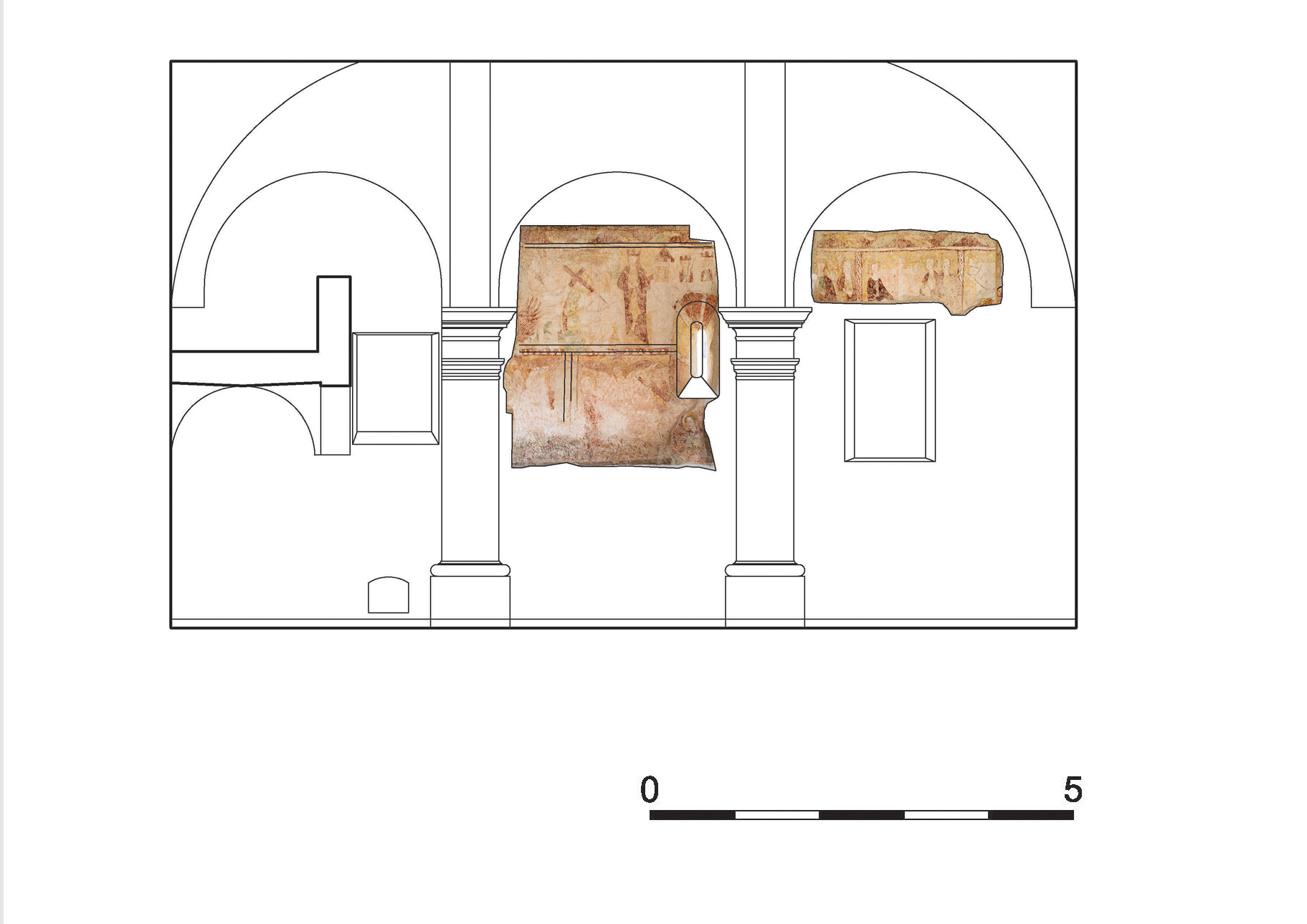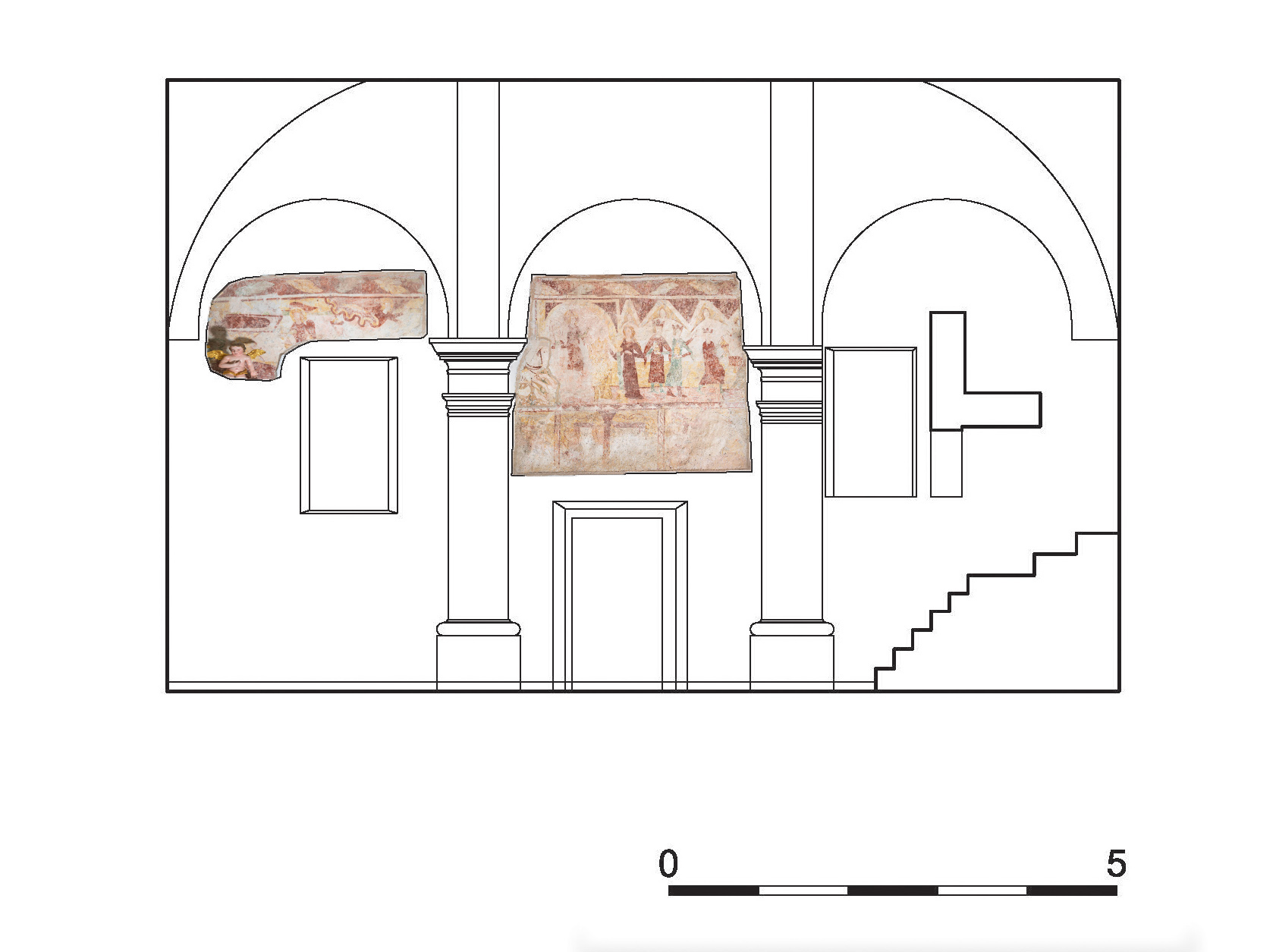











Pigments: white lime, yellow and red earth, green earth, lead pigment (lead white or minium)
Analytical techniques: OM, SEM-EDX
The original plaster had been hammered all over the surface before a fresh layer of plaster was applied to facilitate the painting of the subsequent layer of murals. The resulting holes were sealed during the restoration works. The plaster follows the uneven surface of the wall, but it is impossible to tell how many layers were applied. Given the early date of the paintings, it was probably only a single layer. The plaster is roughly polished. At first glance, it consists of lime and sand, which were not thoroughly mixed, as small white lumps of lime can still be seen in places. A cross-section of a sample (fig. 1), taken from a fragment kept at the Faculty of Arts of the University of Ljubljana, reveals a bright, almost white plaster made of a smaller amount of lime and numerous angular translucent grains of very diverse sizes. Judging from its shape and colour, it is probably quartz or crushed limestone. Unfortunately, the sample did not suffice for an X-ray diffraction analysis to learn the exact composition.
The hues and the mural painting technique (mostly on fresh plaster) suggest the use of white lime, yellow and red earth (alumosilicates and iron oxides), and green earth. The sole sample taken (fig. 1) shows that the red pigment is indeed red earth, rich in iron, silicon, and aluminium. The presence of lead in almost all the SEM-EDX measuring points is surprising: apparently, the painter added a lead pigment to the earth pigment. However, as it has darkened due to atmospheric effects, we do not know whether it was lead white or perhaps minium. The presence of a synthetic pigment is rare in Slovenian medieval paintings, but it can also be found in the oldest murals in the parish church of St George in Ptuj. The high presence of calcium determines the main binder as lime from the plaster or lime added to the pigments. The potential presence of an organic binder could not be determined.
The basic colours were clearly applied on fresh plaster, as they are still quite stable, but many of the additions were likely painted later with pigments to which some organic binder (egg yolk, animal glue, or casein) was added. This is therefore an example of the mixed technique: a mural started al fresco and finished al secco.
No sinopia has been detected. Thin incisions were made into the fresh plaster, defining the outlines of the figures, the bordures between the scenes, and perhaps also the halos. On the lower band of the mural on the southern wall and on the fragment from the Faculty of Arts (fig. 2), a yellow underdrawing can be detected that is not visible elsewhere. In most parts of the painting, a dark red contour predominates, but it is not possible to determine whether this was an underdrawing or the finishing contour. Perhaps the painter first sketched slight outlines, which he then reemphasised in the end. This way, the underdrawing would also serve as a finishing line. However, perhaps he did not need an underdrawing, at least not for the main outlines of the figures, as he had already carved them into the fresh plaster. The painter applied all of the larger colour surfaces very precisely with a broad brush, as they never extend beyond the contours of the figures. Despite the thick paint layers, these are still well preserved. The painter later modelled on these basic local tones. The modelling has mostly fallen off, but we can still see that volume modelling was virtually non-existent.
The faces (fig. 2) are oval in shape, with slightly arched eyebrows and straight noses that continue from the inner eyebrow. The eyes are large, with a semicircular line above and a straight line below. The pupils have mostly fallen off. For the carnation, the painter used a very light, almost white colour, to which he added pink to liven up the cheeks and, in some places, to shade the forehead under the hair. He accentuated the upper eyelids with a soft ochre colour. The hands are large, featuring narrow palms and long fingers. Like the faces, the painter modelled them with pink paint on a very bright, almost white base, after which he outlined them in reddish-brown. Men tend to have shorter bobbed hairstyles, while women are either long-haired or are covered with headdresses. On an ochre-yellow base, the painter drew individual strands of hair with parallel straight or sinuous strokes; the lines often run perpendicular to the head. He used the same colour to outline the entire hairstyle, but any potential shades and highlights are no longer preserved. The modelling of the draperies is almost entirely unpreserved, and it is difficult to distinguish the original work from the subsequent restorations and hatchings. The master drew the lines of the folds with a broad brush on the basic colour surface. There are no soft transitions between colours. Finally, he apparently outlined everything with a dark red contour, which probably followed the presumed underdrawing and the thin contour incisions. The final works include the lines on the architectural conclusions and on the gift jars of the Magi. For the bordure, the painter might have used a stencil.
Vrzdenec near Horjul, Succursal church of St Cantianus, Stage 1 (Vrzdenec, church of St Cantianus), 2024 (last updated 29. 8. 2024). Corpus picturarum muralium medii aevi, https://corpuspicturarum.zrc-sazu.si/en/poslikava/phase-1-church-of-st-cantianus/ (9. 7. 2025).
Legal Terms of Use
© 2025 ZRC SAZU UIFS, Corpus picturarum muralium medii aevi
ZRC SAZU
France Stele Institute of Art History
Novi trg 2
1000 Ljubljana


Spodaj seznam podrobno opisuje piškotke, ki se uporabljajo na našem spletnem mestu.
| Cookie | Type | Duration | Description |
|---|---|---|---|
| _ga | Non-Necessary | 2 years | This cookie is installed by Google Analytics. The cookie is used to calculate visitor, session, camapign data and keep track of site usage for the site's analytics report. The cookies store information anonymously and assigns a randoly generated number to identify unique visitors. |
| _gat | Non-Necessary | 1 minute | Google uses this cookie to distinguish users. |
| _gid | Non-Necessary | 1 day | This cookie is installed by Google Analytics. The cookie is used to store information of how visitors use a website and helps in creating an analytics report of how the wbsite is doing. The data collected including the number visitors, the source where they have come from, and the pages viisted in an anonymous form. |
| cookielawinfo-checkbox-necessary | Necessary | 1 year | This cookie is set by GDPR Cookie Consent plugin. The cookies is used to store the user consent for the cookies in the category "Necessary". |
| cookielawinfo-checkbox-non-necessary | Necessary | 1 year | This cookie is set by GDPR Cookie Consent plugin. The cookies is used to store the user consent for the cookies in the category "Non Necessary". |
| CookieLawInfoConsent | Necessary | 1 year | The cookie is used to store the summary of the consent given for cookie usage. It does not store any personal data. |
| PHPSESSID | session | Time of session | Cookie stores information about the user's session and allow users to keep their entries during the time of visiting the website. |
| pll_language | Necessary | 1 year | This cookie is used to remember any selection a user has made about language. |
| show_preloader_once | Necessary | Session | With this cookie we remember the user's first visit. |
| viewed_cookie_policy | Necessary | 1 year | The cookie is used to store whether or not you have consented to the use of cookies. It does not store any personal data. |